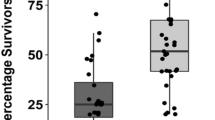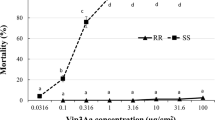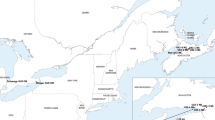Abstract
Several important crops have been engineered to express toxins of Bacillus thuringiensis (Bt) for insect control. In 1999, US farmers planted nearly 8 million hectares (nearly 20 million acres) of transgenic Bt crops approved by the EPA. Bt-transgenic plants can greatly reduce the use of broader spectrum insecticides, but insect resistance may hinder this technology. Present resistance management strategies rely on a “refuge” composed of non-Bt plants to conserve susceptible alleles. We have used Bt-transgenic broccoli plants and the diamondback moth as a model system to examine resistance management strategies. The higher number of larvae on refuge plants in our field tests indicate that a “separate refuge” will be more effective at conserving susceptible larvae than a “mixed refuge” and would thereby reduce the number of homozygous resistant (RR) offspring. Our field tests also examined the strategy of spraying the refuge to prevent economic loss to the crop while maintaining susceptible alleles in the population. Results indicate that great care must be taken to ensure that refuges, particularly those sprayed with efficacious insecticides, produce adequate numbers of susceptible alleles. Each insect/Bt crop system may have unique management requirements because of the biology of the insect, but our studies validate the need for a refuge. As we learn more about how to refine our present resistance management strategies, it is important to also develop the next generation of technology and implementation strategies.
This is a preview of subscription content, access via your institution
Access options
Subscribe to this journal
Receive 12 print issues and online access
$209.00 per year
only $17.42 per issue
Buy this article
- Purchase on Springer Link
- Instant access to full article PDF
Prices may be subject to local taxes which are calculated during checkout



Similar content being viewed by others
References
Roush, R.T. & Shelton, A.M. Assessing the odds; the emergence of resistance to Bt transgenic plants. Nat. Biotechnol. 15, 816–817 ( 1997).
Krattiger, A.F. Insect resistance in crops: a case study of Bacillus thuringiensis (Bt) and its transfer to developing countries. Intl. Svc. for the Acquisition of Agribiotech Appl. (ISAAA) Briefs No. 2. (ISAAA, Ithaca, NY; (1997).
Mellon, M. & Rissler, J. (eds). Now or never: serious plans to save a natural pest control. (Union of Concerned Scientists, Cambridge, MA; 1998).
Roush, R.T. (1994) Managing pests and their resistance to Bacillus thuringiensis: can transgenic crops be better than sprays? Biocontrol Sci. Technol. 4, 501–516 ( 1998).
Texas A&M University. Report filed with US EPA for hearing on 21 May 1997. Docket OPP–0478 (1997).
McGaughey, W.H. & Whalon, M.E. Managing insect resistance to Bacillus thuringiensis toxins. Science 258, 1451–1455 (1992).
Alstad, D.N. & Andow, D.A. Managing the evolution of insect resistance to transgenic plants. Science 268, 1894–1896 (1995).
Tabashnik, B.E. Delaying insect adaptation to transgenic plants: seed mixtures and refugia reconsidered. Proc. R. Soc. Lond. B 255, 7–12 (1994).
Roush, R.T. Can we slow adaptation by pests to insect transgenic crops? In Biotechnology and integrated pest management (ed. Persley, G.) 242–263 (CAB International, Wallingford, UK; 1996).
Roush, R.T. Managing resistance to transgenic crops. In Advances in insect control: the role of transgenic plants. (eds Carozzi, N. & Koziel, M.) 271–294 (Taylor and Francis, London; 1997).
Hargrove, T.R. Wrangling over refuge. Am. Sci. 87, 24– 25 (1999).
Gould, F. & Tabashnik, B. Bt-cotton resistance management. In Now or never: serious new plans to save a natural pest control (eds Mellon, M. & Rissler, J.) 67–105 (Union of Concerned Scientists, Cambridge, MA; 1998).
Shelton, A.M. et al. Resistance of diamondback moth (Lepidoptera: Plutellidae) to Bacillus thuringiensis subspecies in the field. J. Econ. Entomol. 86, 697–705 ( 1993).
Metz, T.M., Tang, J.D., Shelton, A.M., Roush, R.T. & Earle, E.D. Transgenic broccoli expressing a Bacillus thuringiensis insecticidal crystal protein: implications for pest resistance management strategies. Mol. Breeding 1, 309–317 (1995).
Tang, J.D., Gilboa, S., Roush, R.T. & Shelton, A.M. Inheritance, stability and lack of fitness costs of field-selected resistance to Bacillus thuringiensis in diamondback moth (Lepidoptera: Plutellidae) from Florida . J. Econ. Entomol. 90, 732– 741 (1997).
Shelton, A.M., Tang, J.D., Roush, R.T. & Earle, E.D. Can we manage resistance to Bt -engineered plants? Results of greenhouse and field tests. Proceedings of the Sixth Australian Applied Entomological Research Conference, Brisbane, Australia, 29 Sept.–2 Oct. 1998. (eds. M.P. Zalucki, R.A.I. Drew and G.G. White) 258– 266, University of Queensland Printery, 1998).
Tang, J.D. et al. Survival, weight gain, and oviposition of resistant and susceptible Plutella xylostella (L.) (Lepidoptera: Plutellidae) on broccoli expressing Cry1Ac toxin of Bacillus thuringiensis. J. Econ. Entomol. 92, 47–55 ( 1999).
Tang, J.D. et al. Toxicity of Bacillus thuringiensis spore and crystal protein to the resistant diamondback moth (Plutella xylostella). Appl. Environ. Microbiol. 62, 564– 569 (1996).
Tabashnik, B.E. et al. Global variation in the genetic and biochemical basis of diamondback moth resistance to Bacillus thuringiensis. Proc. Natl. Acad. Sci. USA 94, 12780–12785 (1997).
Roush, R.T. Bt-transgenic crops: just another pretty insecticide or a chance for a new start in resistance management? Pesticide Sci. 51, 328–334 (1997).
Llewellyn, D. & Higgins, T.J. (1998) Biotechnological approaches to crop protection: novel sources of insect tolerance genes other than Bt-toxins. Proceedings of the Sixth Australian Applied Entomological Research Conference, Brisbane, Australia, October 1998 .
Talekar, N.T. & Shelton, A.M. Biology, ecology and management of the diamondback moth. Ann. Rev. Entomol. 38, 275–301 (1993).
Metz, T.D., Dixit, R. & Earle, E.D. Agrobacterium tumefaciens-mediated transformation of broccoli (Brassica oleracea var. italica) and cabbage ( B. oleracea var. capitata). Plant Cell Rep. 15, 287–292 (1995).
Perez, C.J. Tang, J.D., & Shelton, A.M. Comparison of leaf-dip and diet bioassays for monitoring Bacillus thuringiensis resistance in field populations of diamondback moth (Lepidoptera: Plutellidae). J. Econ. Entomol. 90, 94–101 (1997).
LeOra Software. Polo-PC: a user's guide to probit or logit analysis. (LeOra Software, Berkeley, CA; 1987 .
Acknowledgements
We thank Melissa Birkett, Hilda Collins, Jennifer Cooley, Bryna Mitchell, Sabrina Siebert, Powell Smith, and Joe Zhao for their assistance in this project. The research was funded by USDA NRI grants 91-37302-6199, 93-01977 and 95-37302-1783.
Author information
Authors and Affiliations
Corresponding author
Rights and permissions
About this article
Cite this article
Shelton, A., Tang, J., Roush, R. et al. Field tests on managing resistance to Bt-engineered plants. Nat Biotechnol 18, 339–342 (2000). https://doi.org/10.1038/73804
Received:
Accepted:
Issue Date:
DOI: https://doi.org/10.1038/73804
This article is cited by
-
Development and evaluation of triple gene transgenic cotton lines expressing three genes (Cry1Ac-Cry2Ab-EPSPS) for lepidopteran insect pests and herbicide tolerance
Scientific Reports (2022)
-
Climate warming promotes pesticide resistance through expanding overwintering range of a global pest
Nature Communications (2021)
-
Assessment of bollworm damage and yield loss in seed blends of Bollgard-II with corresponding Non-Bt hybrid as ‘built in refuge’ in cotton
Phytoparasitica (2021)
-
The fabric of life: what if mosquito nets were durable and widely available but insecticide-free?
Malaria Journal (2020)
-
Pest control and resistance management through release of insects carrying a male-selecting transgene
BMC Biology (2015)



